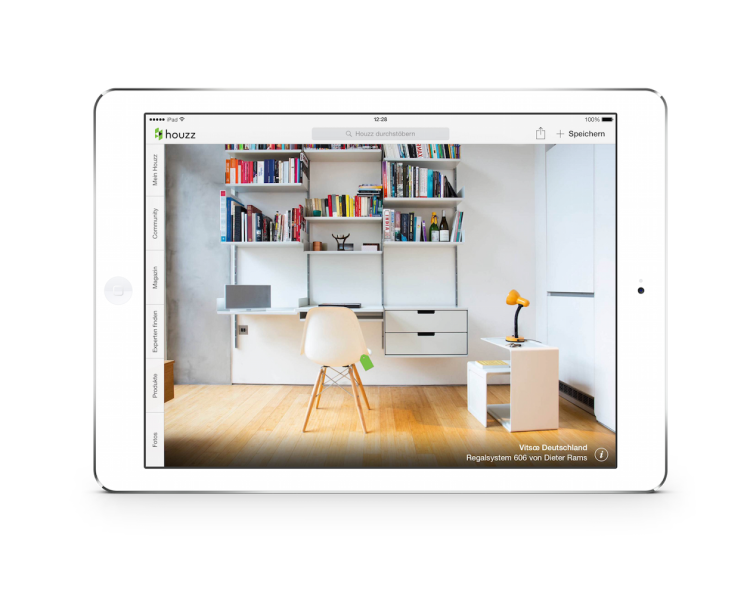Adi Tatarko, CEO and co-founder of Houzz, visited Berlin for the launch of the renovating platform Houzz. She shared some insights on what it’s like to see a business expanding fast and working full-time while raising three children.
Houzz, a leading platform for building, renovating, and interior design, started as a pet project by Adi Tatarko and her husband Alon Cohen in 2010 in San Francisco. Four years and $213.6 million in funding rounds later, Houzz now employs 350 people. Offices are located in the U.K., Germany and Australia. More offices in Europe and Asia are planned for 2015.
Meeting Adi Tatarko
It was the last meeting of the day. After many other interviews and in-between a few moments with her son who turned one that day, CEO and co-founder Adi Tatarko (41) sat down with VentureVillage to discuss the launch of Houzz in Germany.
Though it was already past 6 p.m., she doesn’t seem exhausted or annoyed. Her team prepared the launch party in Berlin’s Gorki Apartments. They brought items from the platform into the rooms. Besides the information and price tags, the features were also put in the rooms such as stickers (e.g. “add photo”) that truly give the feeling of walking through the app.
When she and her husband started Houzz four years ago, she was already a mother of two. Last year this time, son number three arrived. Running a company and raising three kids is a challenge but it’s doable she explained, smiling. Different to some mid-twenty founders, she appears to know where she stands.
Having started Houzz while renovating themselves and working full-time at an investment firm, she said she never expected the company to take off this way. Seeing that it does excites her even more.
Nevertheless, founders know the difference between a company with 10, 25, 100 or 300 people. Keeping a culture of trust and open communication is important to keep it a family (-like) business.
Tatarko says that employees are key for that. 50 percent of her time, she states, is used for hiring. She and her husband interviewed each and every one of the 350 employees themselves and flew some people to San Francisco to meet them in person.
There are good days and bad days, she honestly says. But seeing the impact Houzz has on people’s life is rewarding.
And so is her life, it seems. “Yes, it’s a crazy life,” she says. Seeing how important it is to be with her youngest one on his birthday, it’s obvious that she is CEO and mother at heart. “It’s about prioritising,” she adds. “Once that is clear, things work.”
Houzz as a platform
Houzz states it has over 25 million monthly users, over 500,000 signed up experts and over 4 million high resolution photographs on its platform.
The platform works in five layers. Besides inspiration, as you would find on Pinterest, Houzz also focuses on content that is created by professionals and editors. Besides that, the community plays an important role, because it connects the home owners and the professionals. This benefits both parties: Homeowners can get advice, while professionals, such as lightning consultants, landscapers or architects, can build their own reputation and brand. Homeowners can hire through the website and, since October, customers can also purchase products through Houzz.
What looks like a beautiful furniture website is a actually a huge data machine. “With all the photographs being uploaded every day, Houzz sees actual trends instead of guessing what the color of the season could be,” Tatarko explains.
Monetizing beautiful places and ideas
While you could imagine that a shop commission is the best way to monetize such a business, that was the last of three options Houzz picked.
“We didn’t focus on monetizing but on the community, when we first started,” Tatarko explains. Investors, however, saw the idea taking off early. Houzz has received $165 million Series D funding announced in October 2014 that brought the overall funding to $213.6 million.
There are two other ways Houzz gives extra features for those wanting more than the free tools. On the one hand, large brands can book an ad service. Professionals can also book to appear on a local marketplace to get into the focus of homeowners faster.
Entering the German Market
Houzz opened its office in Berlin in January 2014. The company played it smart by keeping it quiet in Europe until the content and community teams were set up. The 15 employees in Germany are working with the local community and creating content that suits the local market. Having launched Houzz Beta this week, users find a great number of products that fit the European style. This is not only for Germans, however. The styles of smaller apartments is also interesting to U.S. customers, Houzz states.
Germany often provides an attractive market for U.S. startups. Handwerk Magazin found out that the remodeling market in Germany is worth over €35 million. Fab also had just recently started here in Berlin.
Talking to Adi Tatarko, she explained another reason of why the company entered the German market. It is because users actually demanded it. 35 percent of the traffic already came from outside the U.S. Germany is the third international website Houzz launched.
This story originally appeared on VentureVillage. Copyright 2014


